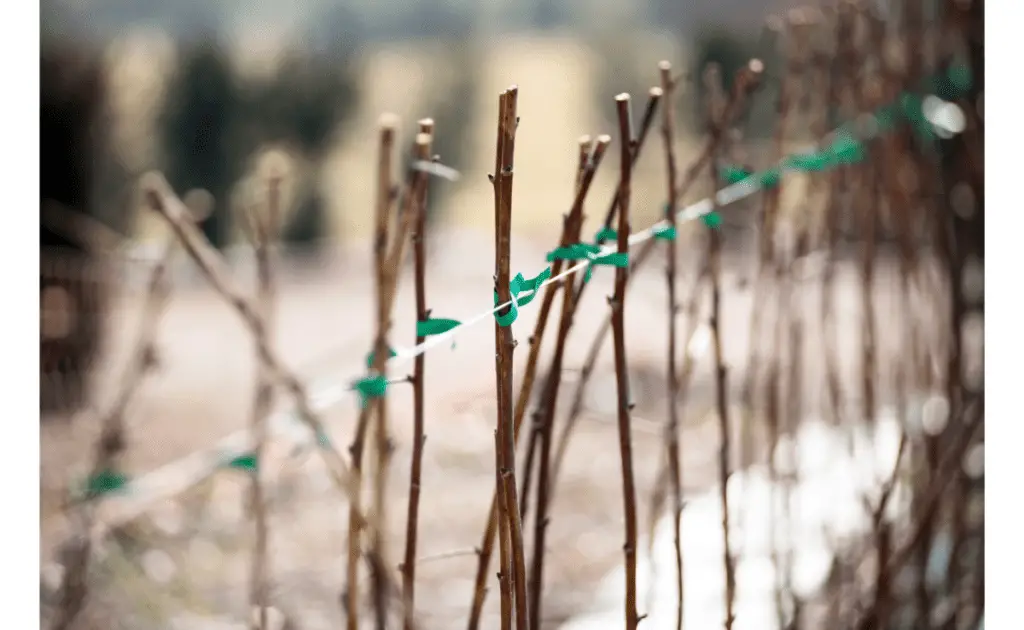
When left unpruned, raspberries become their own bad weed. Lets take a look at some pruning guidance.
How to prune raspberries canes as a whole includes removing weak canes at the base. Cut back the tips of any canes damaged from winter weather. Trellis or tie up raspberry canes making sure to trim enough canes to allow for airflow. Airflow is important to reduce disease and let light access to all the berries for best performance. When to cut back raspberries is on a biennial bases depending on if the cane is new or old.
When left unpruned, raspberries become their own bad weed. When the canes become overcrowded, they tend to compete for sunlight, which leads to the death of the shaded buds and leaves on the bottom part of the plant. And minus those buds, you’ll get fewer branches that fruit and in the long run you’ll get less crop.
Aside from that, crowded canes complete for water and nutrients, which causes poor, small-tasting fruit. Plus, the shady and moist conditions surrounded by the thicket are a source of fungal infections and diseases, like spur blight, anthracnose, and grey mold.
To avoid such problems from occurring, you should prune. A routinely thinning every year, enables for a lot of sunlight and air to circulate freely in the bramble, which implies that you’ll get healthier, bigger crops as a seamless way of picking the ripe sweet red berries.
When Should Raspberries Be Cut Back?
The way raspberries grow and fruit is unique. The plant’s crown and roots are perennial, whereas the cane or the stems are biennial. Every red, spring, purple, and black raspberry produce canes from buds that are located at the lower end of the preceding year’s growth. Besides, red raspberries come from shoots from buds that are situated on their roots. The specific stems stay for two years, then they die off.
Essentially, all raspberries need to be pruned in the month of March or better still, early April. Let’s now see the late winter-spring pruning steps for a wide range of types of raspberries.
Summer-bearing red raspberries
Get rid of the weak and diseased canes at the lower level. For the vigorous canes, leave them. After thinning has been done, the canes that remain need to be spaced up to six inches each side. Get rid of the tips of canes that have died because of winter injury. Ensure you cut back to the live tissue.
Fall-Bearing red raspberries
This option offers both a fall and summer plant. When to prune raspberries is essentially dependent on the type of plant that you are growing. For the everbearing or sometimes referred to as fall-bearing, which produce two crops: fall and summer. Summer crops or at times referred to as summer bearing make fruit on the preceding season’s canes, which can be harvested after you harvest the summer harvest, and also during spring after the frost threat and before a new month starts. Finally, the fall-bearing type is made on the initial year’s canes and as such, they are pruned back after you’ve harvested the late fall harvest when the plant is very dormant.
How Do You Trim Raspberries?
Get rid of last year’s canes: For any late winter pruning process, all you should focus on is removing any canes arising from last year’s harvest. Removing any dead canes helps in preventing the spread of disease spores from wintering and spreading on the new raspberries. Floricanes are usually characterized by old fruiting lateral branches and gray back peeling. Therefore, you should get rid of any old canes right from the ground to prevent all this.
Narrowing the row: Raspberries usually require a row width of between 1.5- 2 feet. Therefore, if you see any cane growing outside this perimeter then you should prune that immediately. Whenever you keep the rows narrow, it makes it convenient to reach the fruits during the harvesting period and prevents some diseases.
Cut out any weaklings: Some plants row could be having some weak canes, these should be removed. Any cane that appears to be short, spindly, or exhibits any insect or pest infestation should as well be cut. These final cuts are usually the thinning cuts. The remaining canes in the row should be tall, healthy, thick, and looking good. You should continue cutting out those unwanted canes and retain the rest in a more spaced manner. You should ensure that they are well spaced to avoid shading and growing so close to each other. Ideally, you will be done pruning whenever you can see some three to five canes in each linear foot.
Trellis the canes: There is a wide range of trellis-style, but it is suitable to stick with V-trellising style if you have red raspberries. With this style, you will have two parallel wires that are spaced 3 feet apart. You should run this outside the row of the raspberries. You can then attach these wires to the support posts at the end and set them 4 feet above the ground.
You can use rubber bands, twist ties, or tomato ties to attach each raspberry to the wire. These ties should be easy to remove at any time. From here, you can tie the canes in such a way that half the canes are on one side and the other is on the other side. Since the row has a width of 2 feet at the base while you are spreading the canes out to 3 feet wide, they will form a V shape. There will be an opening that allows for light penetration, air movement and prevents the growth of any fungal diseases. Also, this inhibits the growth of the canes outside the rows but rather at the center of the row.
Moreover, this trellising method puts all the fruiting canes on the outside and the new canes at the center to ease harvesting and prevent wastage of fruits. After tying all the canes to the wire, you should bring together all the discarded canes and throw them away. Leaving them on the farm can harbor some diseases and pests.
Pruning Black Raspberries

Black raspberry canes are biennial just like those of red raspberries. However, these black raspberries have a different growing habit that requires you to go an extra step while pruning. The canes of black raspberries usually grow taller as compared to those of red raspberries. Also, their tips usually arch down to the ground to form some roots which later create new plants. This is so helpful while propagating but it can lead to overcrowding.
Another major difference comes where the primocanes of the black raspberries grow side shoots while this only happens on the floricanes of the red raspberries. These branches usually grow into buds that bear fruit in the coming year. You can encourage more bud development as you prevent the tips from rooting by tipping the primocanes of the black raspberries before they get taller during the summer season.
These canes usually grow up to a length of 30 inches, so you should cut off about 2 to 3 inches of the stem. This encourages side shoots and fruit bud development. Additionally, it makes it easier to maintain the cane to a reachable height while harvesting. When later winter befalls, you can prune them just like the red raspberries.
How To Tell The Difference Between Summer And Autumn Raspberries?
The next thing is to have the difference between summer and autumn raspberries fruiting. In case the canes produce fruits around the month of September, the type is autumn fruiting. For the summer fruiting, they are usually ready around June or July. To prune the autumn fruiting varieties, it is quite simple and direct – just cut down the canes of the plant completely.
With that in consideration, when should you now cut back the autumn plant?
Well, autumn fruiting raspberry is also referred to as a primocane flower and fruit in the same season of growth. So, follow this simple step:
-In February, prune back all the canes to the ground
-In summer, lower the number of canes a bit if it overcrowded
-In summer as well, get rid of any suckers that are growing in the opposite direction of the rows.
Besides, you may wonder why your raspberry plants do not give fruit. If you prune the canes of a 1-year-old raspberry or they die off during winter, your plant won’t give any fruit because they should be at last two years left in the season.
Of course, pruning raspberries isn’t an easy job, neither is it straightforward, it can get brutal at times. However, if you can prune in the right way, you’ll enable your plant to grow vigorously, which in turn enables it to grow big, healthier, and nutritious berries. Aside from that, out of pruning, you open more space for convenient picking of the fruits. Even better, air circulation is increased and the condition for harboring pests and diseases is eradicated, and you’ll have vigorous growth in your garden. Pruning also helps you to control the unwanted growth of the raspberry plant, with no wastage of the weak plant growing.
Overall, you’ll gain alot by pruning your raspberry. And the process of pruning is simple, follow every step we’ve highlighted in this post, and you’ll emerge out successful! Plus, ensure to use the right tool when pruning, a sharp, clean, or sterilized pruner, for an excellent result. What’s more, prune while paying attention to the type of raspberry.
This post contains affiliate links. If you make a purchase through these links, we may receive compensation at no additional cost to you.

